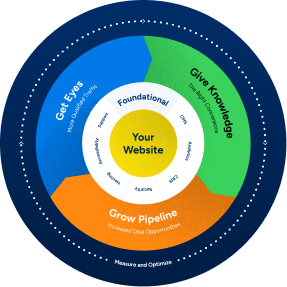The concept of a sales funnel was first defined in 1898 by American advertising visionary Elmo Lewis, who codified the formal theory on the mechanisms of personal selling by studying the mechanisms of his top-performing salespeople in the life insurance market. In comparing the journey that turned leads into customers, Lewis began to notice that the most successful sellers utilized a four-level pipeline with distinct separations between stages. He formally codified these stages into awareness, interest, desire, and action–or AIDA for short–and thus created the first widely-accepted theory of sales and marketing.
This theory has undergone a series of transformations over the last century, but its essence has always stayed the same–a client relationship must be nurtured at each phase of the pipeline to progress to the next level. GoingClear has a history of tweaking the sales funnels of top-tier B2B companies in Boston. Are you ready to take a deep dive into your B2B sales cycle?
Sales Funnel Stages
Over the last century, the stages of a successful sales funnel have occasionally been reorganized and redefined, but the main purpose of the pipeline has stayed the same–that is, the process of converting visitors into leads and then leads into sales. Management of a potential B2B client’s journey can be complex, depending upon many factors. Industry, length of the sales cycle, and profile of an ideal customer all have an impact. The current prevailing theory names the following five stages for a successful B2B sales funnel:
- Awareness
- Interest
- Evaluation
- Engagement
- Purchase
To grow and optimize your B2B sales funnel, you must understand what stage of the acquisition process each lead has reached to best manage and nurture the leads into active customers. Without being aware of the stages–and the gaps that may exist–in your sales funnel, your sales and marketing teams cannot optimize the process to improve conversion rates. Let’s take a closer look at how these stages apply to a potential B2B customer.
Awareness
A B2B decision-maker is in the awareness stage once you have captured their attention. The prospect may have seen social media activity, been forwarded a Facebook post by a friend or colleague, or has noticed that your company offers a previously unheard-of answer while searching Google for a solution to a problem. Once a prospect is in this stage, you can best maximize the possibility that they will remember or engage with your brand by providing quality high-level information and content relevant to your products and services.
Interest
The interest stage occurs when a potential B2B decision-maker is gathering information specific to your company’s goods or services. Establishing trust at this stage is generally the determining factor as to whether or not the lead will pursue a business relationship with your organization. Nurturing the lead here means boosting their opinion of your brand as an expert source in your particular field, or demonstrating that your B2B company has a unique solution to a common problem in your target industry.
Evaluation
A buyer has reached the evaluation stage when you have firmly captured their attention and they are evaluating the benefits of your solution, along with whether it is suitable and effective for their needs. Studies indicate that 64% of C-suite execs spend upwards of 30 hours researching a large-scale B2B solution.
Although many B2B buyers undertake their research when making decisions about the benefits of the solution your organization can provide, your sales team can make or break the lead at this phase. Building trust and demonstrating integrity to a potential client can both set the stage for a long-term relationship, or help to foster a business relationship that can prove beneficial at a future point, with or without an immediate purchase.
Engagement
The engagement portion of the sales cycle is when your sales team has the most important interactions when attempting to convert a lead into a buyer. Product demonstrations, sales materials, pitch meetings, and team communications all provide a clear path to conversion in the B2B customer relationship. Personalized cold emails are an excellent way to provide interesting and engaging content to a potential B2B customer.
Purchase
The purchase, or buying, stage represents a successful conversion of a lead into a paying customer, via careful nurturing through the sales pipeline. By identifying and breaking down the key steps of a B2B buyer’s journey, a sales funnel can be customized to deliver the highest conversion of the most desirable B2B clients into purchasers of your company’s goods and services.
Effective B2B Sales Funnels
In the traditional B2C sales funnel, the purchase stage is the final stage, but the current account-based marketing advancements have changed the “endpoint” of the sales funnel. It is for this reason that post-purchase engagement is the key to building the strongest B2B sales pipeline. Keeping your B2B customer happy increases referrals to friends and industry colleagues. Such referrals are known to convert at a rate of 30% or higher.
Following the five stages outlined above is only a loose collection of ideas on how to best build a successful sales funnel that guides a potential customer from cold contact to purchase. Understanding the unique sales journey of a B2B buyer is different from understanding the often emotion-based journey of a B2C buyer. The B2B buyer instead considers the value of your solution, the relationship you’ve built with other buyers in the space, the reputation of your customer service team, and how they interact with companies that are already customers.
Get In Touch With No.1 B2B Marketing Company
GoingClear is a full-service solution for your B2B company’s marketing and sales needs. If there are gaps in your sales pipeline where highly desirable leads tend to exit the sales cycle, our team of experts is here to help.
Get in touch with Boston’s No.1 B2B marketing company to learn how we can identify and plug the gaps in your funnel and increase your lead conversion rate for 2022 and beyond.

